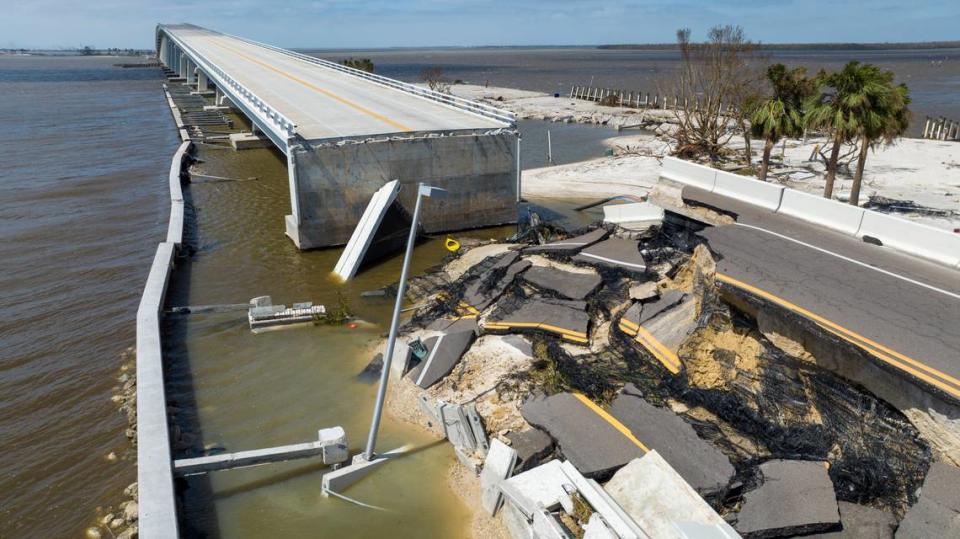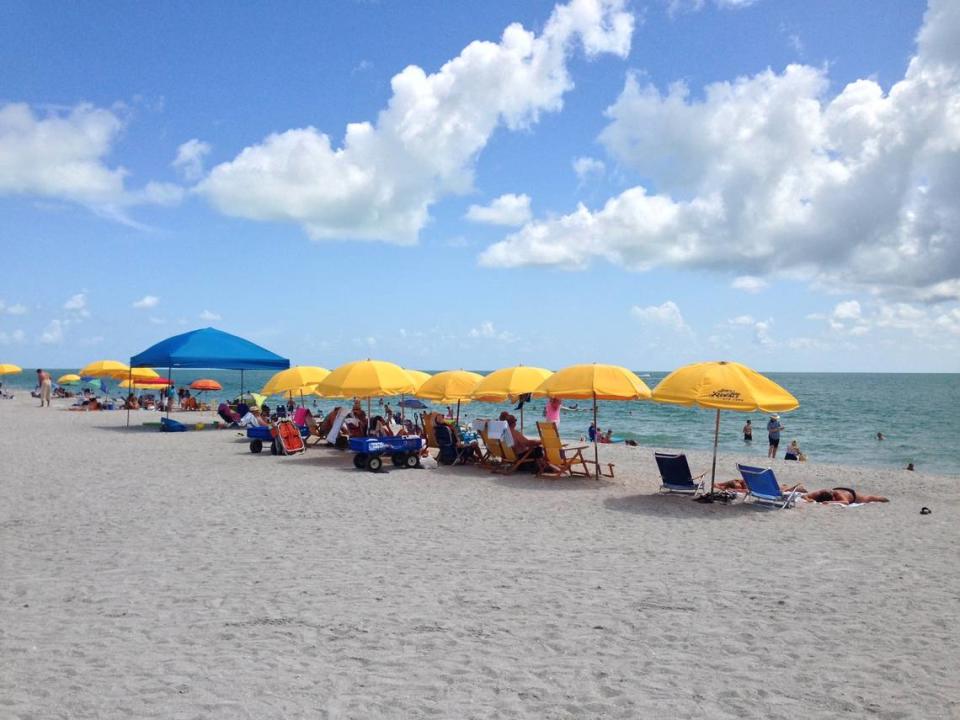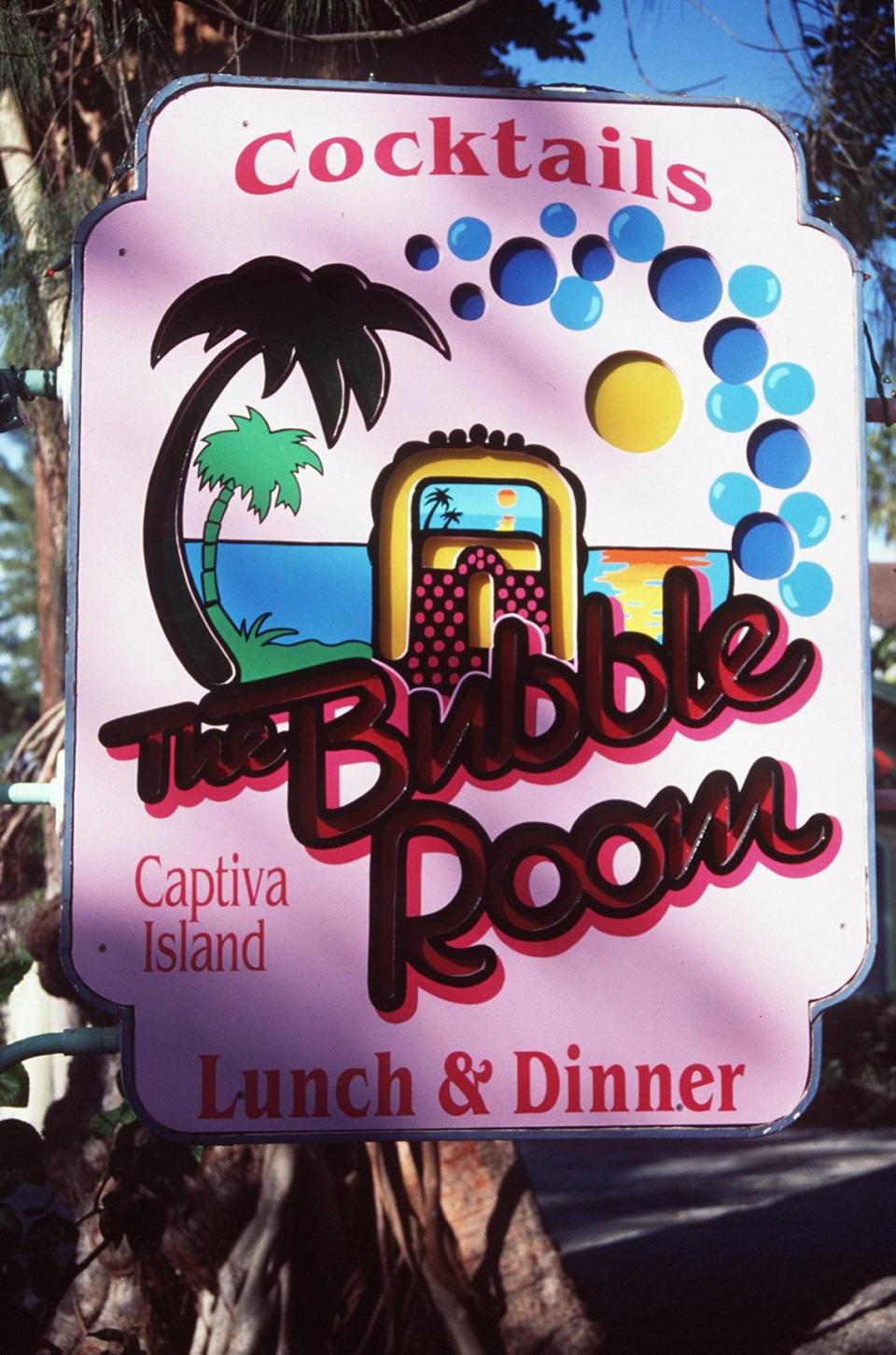‘We’re sitting here terrified.’ Sanibel residents await news about their idyllic island
Howard Simon and his wife, Beth Wilson, left the hubbub of Miami for the tranquility of Sanibel in early 2019.
Their retirement, however, was jolted on Tuesday evening when the couple — along with thousands of neighbors — were forced to evacuate the barrier island on Florida’s southwest coast as Hurricane Ian was threatening to pound them.
Now, Simon says he doesn’t have a clue about what has happened to their home or all their belongings because the near-Category 5 hurricane severed the Sanibel Causeway that links up with the mainland near Fort Myers. The causeway is the only road in and out of Sanibel and Captiva.

“We evacuated at the last minute,” Simon, 79, the former executive director of the American Civil Liberties Union of Florida, said Thursday from a friend’s home in Estero, where he, his wife and their two cats rode out the storm. “Everything we own is tied up in this house, and we don’t know if it’s still there.”
Simon, who moved from Detroit to Miami in 1997 to work for the ACLU in Florida, said he and his wife loved their life in Sanibel. Their three-bedroom, two-and-half-bath home was only a 12-minute walk from one of the island’s most popular spots, Bowman’s Beach.
“I’m trying to keep my mind on other things,” he said, “but we’re sitting here terrified. I don’t have any idea when we can return home.”
That worrisome question now hangs over the idyllic barrier islands of both Sanibel and Captiva after the ferocious storm severed the causeway and bridge in several places. How many people — families, children or retirees — were still stranded on the pair of islands? Or worse, was anybody injured or killed when the near-Category 5 storm slammed into them on Wednesday? The News Service of Florida reported Thursday that five people died in Lee County, although authorities did not identify the deceased or where they had died.
Sanibel Mayor Holly Smith expressed grave concerns about Ian’s devastation in a hurricane update Thursday afternoon, saying “all of our lives and our island have been forever changed.”
“The coming days ahead will be difficult,” Smith wrote on the town’s website. “Our first priority is to get those who are stranded to safety.”
READ MORE: Your favorite Sanibel hangouts were ground zero of hurricane. A look at some of them
No numbers on people stranded in Sanibel, Captiva
Smith did not specify how many people were stranded — dozens or hundreds — but she encouraged residents to provide names and addresses of those who remained on the island during the storm. The mayor also noted she and Sanibel’s city manager had spoken with Gov. Ron DeSantis, and that he pledged his support in the search, rescue and recovery efforts, including boats now headed to the island.
“All individuals on the island need to be taken off,” Smith wrote. “Presently, there can be no time frame for reentry. It just isn’t possible.”

On Thursday afternoon, following his first aerial tour of the hurricane’s destruction, DeSantis declared that Sanibel had been “hit with really Biblical storm surge.” Earlier in the day, he said the causeway to Sanibel and Captiva islands was badly damaged and impassable, and that it will need to be rebuilt.
Residents calling 911 due to rising waters
He also said hundreds of people in Lee County were calling 911 because of rising water in their homes. Besides Sanibel and Captiva, Lee County is the home of Fort Myers, Fort Myers Beach, Bonita Springs and other cities hammered by Ian.
“Of course, those folks are now going to be checked on and so I think we will have more clarity about that in the next day or so,” DeSantis said at a morning news conference. “My sense is that the water was very, very high.”
READ MORE: ‘Help is on the way’: DeSantis says hundreds have called 911, rescue efforts underway
Lee County officials seemed under siege by Ian’s overwhelming destruction.
“Our community looks like it’s been hit by a very large tornado,” Lee County manager Roger Desjarlais said at a Thursday afternoon press conference. “We have a lot of residents who have lost their homes.”
Desjarlais said potable water and water treatment systems have failed countywide.
He also said there are five sections of the Sanibel Causeway “that have just fallen away.” In addition, all bridges leading to Pine Island have “failed.”
Lee County Sheriff Carmine Marceno said that during and after the storm, the county’s welfare line received “such an influx of calls” that many got disconnected, with “a couple thousand” on hold at one point. The sheriff added that on Wednesday night and early Thursday morning, he personally witnessed emergency responders make dozens of rescues “in waist-high water.”
“We are rescuing as we speak,” Marceno added.
Miami-Dade Fire Rescue on scene
About 60 members of Miami-Dade Fire Rescue’s Task Force 1 Team were staged at the Naples Airport as of Thursday afternoon, according to Claudine Buzzo of Metro-Dade Firefighters Local 1403. The team is beginning search-and-rescue efforts in the hardest-hit areas, like Sanibel and Captiva.
Task Force 1 team members told Buzzo that pictures of the damage “don’t do it justice. The text messages I’m getting are saying that it looks like total destruction,” she said. “It looks like what Homestead looked like after Hurricane Andrew.”
Buzzo said some of the members needed to get helicoptered into the area because of the massive damage to the Sanibel Causeway. She added that the team will likely assess the damage using drones before targeting the worst-hit areas.
Lee County authorities had issued a mandatory evacuation of the two islands before Hurricane Ian struck Southwest Florida’s coast Wednesday, but it’s not known how many residents or tourists stayed.
While both islands are renowned tourist destinations known for their pure-white sands, shell-collecting, bird-watching and all-around chill vibe, larger Sanibel and smaller Captiva have a combined year-round population of more than 6,000 people with an elementary school, a medical center and police and fire departments.
Ominous signs of destruction were evident, according to an eyewitness account by the Tampa Bay Times, which reported that overnight an alarm at the toll was bleating endlessly on the Sanibel Causeway. A step beyond it, the road gave way.
READ MORE: Ian’s path of ruin: Sanibel bridge severed, Gulf Coast cities flooded
Portion of the bridge is gone
One of the first sections of the span, where the bridge rises from the mainland toward the island, had disappeared. Crumbled pavement lay near the water’s edge. The rest of the bridge stretched forward, unreachable.
Under the toll plaza sign — a half-mile out — McGregor Road to Sanibel Island was impassable. The pavement folded up like an accordion, ripped to ribbons by the powerful storm surge. Nearby, a spiral staircase was deposited in the brush next to a white pickup. The storm flung a boat trailer and other debris, too.

The damage wrought by Ian on the other side of the Sanibel Causeway, built nearly 60 years ago, was still unknown Thursday.

Sanibel and Captiva Islands were created by rising sea levels that separated them from the mainland a few thousand years ago. The native Calusa Indians were the first-known residents of the island. But over the centuries Spanish explorers, pirates, Native Americans and pioneer settlers have shaped the history of both Sanibel and Captiva, which were sliced apart during a hurricane in 1921.
Bubble Room, Sundial and other landmarks in Ian’s path
The Sanibel Causeway, built in 1963, threatened to overwhelm the sanctuary islands with residents and tourists. But despite the inevitable growth, they retained their charm and solitude, becoming homes for the author Randy Wayne White and the late painter Robert Rauschenberg.
But one unwelcome visitor, Hurricane Charley, directly hit the islands in 2004, though not with the same ferocity as Ian.

Now, with its causeway severed by the Category 4 hurricane, accounting for the number of lives lost and businesses closed will take time. Many of the islands’ landmarks, from the Sundial resort in Sanibel to the ‘Tween Waters resort and Bubble Room restaurant in Captiva, will remain inaccessible.
As of Thursday, however, the Sanibel Lighthouse, also known as Point Ybel Light, was standing tall, although it wasn’t clear whether the historical landmark was damaged.
The lighthouse, which stands 98 feet above sea level, first illuminated the beach and pier on the east end of the island in 1884.
Tampa Bay Times reporter Zachary T. Sampson contributed to this report.

 Yahoo Movies
Yahoo Movies 